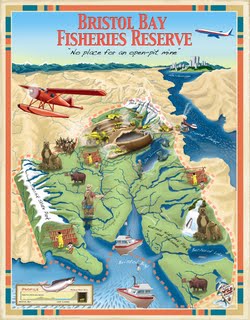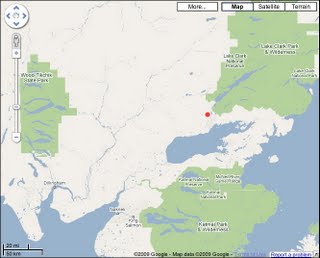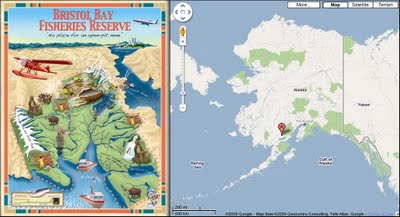25 Nov 2009 Election Law-Violating Astroturf Group Misleads About Pebble Mine… Now There’s a Surprise
Alaska Wild Salmon Protection’s advertisement was filled with distortions, but more on that later.
I wanted to learn more about the group, so I went to check out its website. It didn’t have one.* Odd, I thought, for an environmental group leading local opposition to the Pebble Mine.
It turns out that the closest Alaska Wild Salmon Protection, Inc. comes to anything remotely environmental is astroturf.
The group was created by the law firm of Holmes, Weddle & Barcott as a front for a client trying to stop the Pebble Mine project. Corporate clients find anonymity provided by such arrangements quite liberating: They can feel free to say whatever they want without fear of accountability for their actions.
The group was incorporated by William DeVoe, Michael Barcott, and Timothy McKeever, all attorneys with the firm. McKeever is perhaps best known as the former chief of staff to Alaska’s ethically-challenged former Senator, Ted Stevens. He was the center of a controversy in last year’s elections when he acknowledged lobbying the Senator on behalf of one of his clients while serving as Stevens’ campaign treasurer.
Until recently, it wasn’t known who was bankrolling Alaska Wild Salmon Protection, Inc. But thanks to a report by the Alaska Public Offices Commission (APOC), we now know it is Robert Gillam, CEO of McKinley Capital Management (more on him here).
According to a June 2009 APOC report, Alaska Wild Salmon, Inc. was “…set up to be another 501(c)(6), and its purpose was to allow Gillam to spend money on lobbying without disclosing that he was employing lobbyists.” The report further found that Gillam and associates had committed 18 violations of Alaska state election law related to an anti-Pebble Mine ballot initiative, including “using the names of others” to conceal the true source of ballot initiative contributions.
A proposal by the defendants to settle the case for $30,000 was rejected by APOC several weeks ago. APOC has now voted to dismiss some related allegations, but is seeking another hearingon campaign finance law violation charges.
More detail comes from a November 23 editorial in the Anchorage Daily News:
…Still at issue is the charge, backed by APOC investigators, that Anchorage businessman Bob Gillam and others sought to hide about $2 million of his contributions to the cause. APOC wisely rejected a proposed $30,000 settlement with Gillam and others in that case.
Their decision was wise because the attempt to hide the backers of initiative campaigns in Alaska is an attempt to withhold information from Alaska voters. In this case, initiative supporters worried that Gillam’s bankrolling would underscore his personal stake in stopping the mine — he owns a lodge near the Pebble prospect — and draw attention from the environmental and public policy arguments.
So they sought ways — particularly through the cover of a shell outfit called Americans for Job Security — to keep Gillam’s name from his contributions.
That shell game has no place in Alaska elections.
Alaskans need to know who’s bankrolling both sides of an initiative and why. No hiding behind front groups…
Now on to the advertisement distortions…
AWSP’s advertisement includes a rendering of the Pebble Mine and the surrounding areas with the caption “No place for an open-pit mine.”
If the ad’s map was anything close to an accurate representation of the area, they might be right. But it’s not.
Though not intended to be drawn to scale (a pictured fisherman, for example, would have to be a Paul Bunyan to Paul Bunyan for that to be the case), the map was clearly designed to mislead readers about the location of the proposed mine and the degree to which it would threaten water and wildlife resources in the area.
The ad suggests…
…the mine would be located where three parks — the Wood-Tikchik State Park, Katmai National Park and Preserve and Lake Clark National Park and Preserve converge.
The truth: They don’t converge at all. The proposed mine, shown as the red dot, is 90+ miles from the Wood-Tikchik State Park (green patch at the left in Google map pictured below), about 14 miles from the nearest part of Lake Clark National Park (green patch in the upper right), and 50+ miles from Katmai National Park (green patch in the lower right).
…the mine would be right next to Lake Iliamna.
The truth: The mine would be nearly 20 miles away from Lake Iliamna.
The ad suggests…
…the mine would be very close to the Cook Inlet.
The truth: It would be some 70 miles away from the Cook Inlet.
The ad suggests…
…the mine would be enormous. The rendering shows the Pebble Mine’s width at twice the distance between the mine’s western edge and Wood-Tikchik State Park, suggesting a mine some 180 miles in length.
The truth: No one knows how wide the mine would be as a site plan has neither been submitted nor approved. However, it is unlikely to exceed two miles wide at any point.
A side-by-side comparison of the ad to a map of Alaska with the three parks shown in green gives a more honest perspective of the size of the mine and the sizes and relationships involved (“A” is the location of the Pebble Mine).
All these advertising distortions should surprise no one.
If you don’t tell the truth in campaign disclosures, why would you do so in your advertisements?
*Note: After this blog post was drafted, but before it was published, the Alaska Wild Salmon Protection, Inc. trade association launched its website. The domain name was reserved on October 30, 2009, two years after the trade association was incorporated and about the same time the group ran the Politico ad. In registering its domain, the trade association opted to keep its registration information private.






